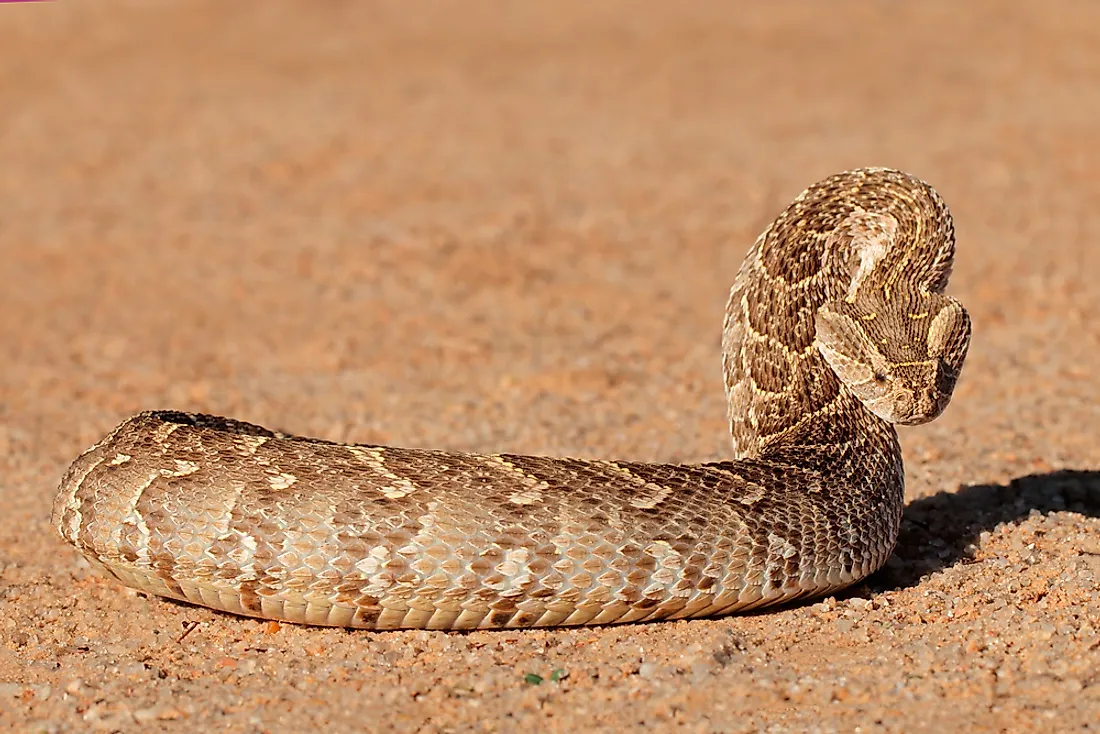Deadly Snakes Found in Africa

8. Puff Adder
The puff adder (Bitis arietans) is a highly venomous species of viper found throughout Africa with the exception of the Sahara Desert region and the African rainforests. These snakes produce a cytotoxic venom and as per research, if left untreated, about 100 milligrams of the puff adder venom is sufficient to kill adult human males within 25 hours post-bite. The snakes are responsible for the greatest number of snakebite fatalities in Africa because of their widespread occurrence, tendency to inhabit human inhabited areas and aggressive disposition.
7. Gaboon Viper
The Gaboon viper (Bitis gabonica) is one of the most elusive and least aggressive but highly venomous species of viper found in the rainforests and savanna of Africa. Only around 70 to 100 milligrams of the cytotoxic venom from these vipers is sufficient to kill an adult human being. The fact that these snakes reside in the dense rainforests and are extremely lethargic in nature guarantees that snakebite cases concerning the Gaboon viper are rare. Most often, these snakes bite only when someone steps on them accidentally. These snakes also have the highest venom yield among the venomous snakes of the world.
6. Egyptian Cobra
The Egyptian cobra is one of the largest cobra species that is native to Africa, found to the north and south of the Sahara Desert region, in the West African savanna, and in Kenya and Tanzania in eastern Africa. These snakes produce a highly potent venom with both neurotoxic and cytotoxic components, potent enough to kill adult human beings.
5. Eastern Green Mamba
The eastern green mamba (Dendroaspis angusticeps) is a highly venomous species of snake found in the coastal regions of eastern and southern Africa with their range extending from Kenya to South Africa, and also into the Zanzibar islands. The snakes are largely arboreal and remain well camouflaged within trees and bushes by virtue of their green color. Green mamba venom is extremely potent, a toxic cocktail of cardiotoxins, neurotoxins, fasciculins, and calcicludine. Deaths within half an hour of receiving a snake bite from the green mamba have been known to occur. These snakes are often known to enter human homes in search of food and sometimes inhabit the thatched roofs of such homes.
4. Carpet Viper
The carpet vipers, or Echis, are a genus of vipers of highly poisonous nature widely distributed across Africa, Middle East, and South Asia. In Africa, these snakes are found in a wide variety of habitats across the continent. The snakes produce an extremely potent hemotoxin that is lethal in very low doses. These snakes are responsible for the greatest number of snakebite fatalities in the areas where they occur. Since the snakes are nocturnal in nature, most of the snakebites occur after dark, and in remote areas where medical facilities are not immediately accessible, fatalities are almost always inevitable.
3. Cape Cobra
If left untreated, the Cape cobra (Naja nivea) bite is potent enough to kill an adult human being within 1 to 10 hours post snake bite. The venom is a toxic mix of neurotoxins and cardiotoxins that attack the nervous system, respiratory system, and the heart. The cape cobra is found in southern Africa in a wide variety of habitats, including the savannas, deserts, semi-desert regions, and bushvelds.
2. Boomslang
The boomslang (Dispholidus typus) is one of the most venomous species of snakes in the world and is native to Sub-Saharan Africa. The snake produces a highly potent hemotoxin which disrupts the blood coagulation process within the body of the victim and triggers death by massive internal and external bleeding. Since the venom of the boomslang takes hours to act, it helps victims to seek immediate medical attention. However, some victims tend to ignore the bite due to the absence of immediate symptoms and this often leads to fatalities due to negligence.
1. Black Mamba
In Africa, the bite of the black mamba (Dendroaspis polylepis) is locally known as “the kiss of death” and it is regarded as the most dangerous species of snake in the continent. The black mamba is known to strike from a considerable range, delivering a potent neurotoxic venom through single or repeated strikes that trigger death dealing symptoms within 45 minutes of the bite. Prior to the availability of antivenom treatments, human death by black mamba bites was almost 100% certain. These snakes occupy terrestrial habitats like savanna, rocky slopes, and woodlands in Sub-Saharan Africa. The snake is well recognized for its high speed on land. Though the black mamba is so feared, scientists studying their behavior have reported that these snakes usually try to avoid humans and do not strike unless threatened.











